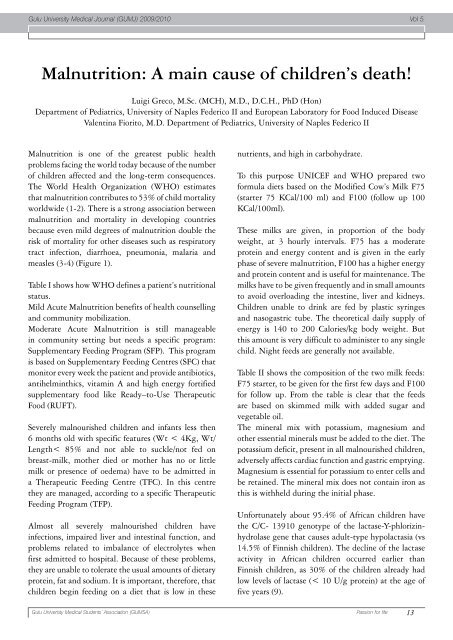GULU UNIVERSITY MEDICAL JOURNAL
GULU UNIVERSITY MEDICAL JOURNAL
GULU UNIVERSITY MEDICAL JOURNAL
Create successful ePaper yourself
Turn your PDF publications into a flip-book with our unique Google optimized e-Paper software.
Gulu University Medical Journal (GUMJ) 2009/2010 Vol 5.<br />
Malnutrition: A main cause of children’s death!<br />
Luigi Greco, M.Sc. (MCH), M.D., D.C.H., PhD (Hon)<br />
Department of Pediatrics, University of Naples Federico II and European Laboratory for Food Induced Disease<br />
Valentina Fiorito, M.D. Department of Pediatrics, University of Naples Federico II<br />
Malnutrition is one of the greatest public health<br />
problems facing the world today because of the number<br />
of children affected and the long-term consequences.<br />
The World Health Organization (WHO) estimates<br />
that malnutrition contributes to 53% of child mortality<br />
worldwide (1-2). There is a strong association between<br />
malnutrition and mortality in developing countries<br />
because even mild degrees of malnutrition double the<br />
risk of mortality for other diseases such as respiratory<br />
tract infection, diarrhoea, pneumonia, malaria and<br />
measles (3-4) (Figure 1).<br />
Table I shows how WHO defines a patient’s nutritional<br />
status.<br />
Mild Acute Malnutrition benefits of health counselling<br />
and community mobilization.<br />
Moderate Acute Malnutrition is still manageable<br />
in community setting but needs a specific program:<br />
Supplementary Feeding Program (SFP). This program<br />
is based on Supplementary Feeding Centres (SFC) that<br />
monitor every week the patient and provide antibiotics,<br />
antihelminthics, vitamin A and high energy fortified<br />
supplementary food like Ready–to-Use Therapeutic<br />
Food (RUFT).<br />
Severely malnourished children and infants less then<br />
6 months old with specific features (Wt < 4Kg, Wt/<br />
Length< 85% and not able to suckle/not fed on<br />
breast-milk, mother died or mother has no or little<br />
milk or presence of oedema) have to be admitted in<br />
a Therapeutic Feeding Centre (TFC). In this centre<br />
they are managed, according to a specific Therapeutic<br />
Feeding Program (TFP).<br />
Almost all severely malnourished children have<br />
infections, impaired liver and intestinal function, and<br />
problems related to imbalance of electrolytes when<br />
first admitted to hospital. Because of these problems,<br />
they are unable to tolerate the usual amounts of dietary<br />
protein, fat and sodium. It is important, therefore, that<br />
children begin feeding on a diet that is low in these<br />
nutrients, and high in carbohydrate.<br />
To this purpose UNICEF and WHO prepared two<br />
formula diets based on the Modified Cow’s Milk F75<br />
(starter 75 KCal/100 ml) and F100 (follow up 100<br />
KCal/100ml).<br />
These milks are given, in proportion of the body<br />
weight, at 3 hourly intervals. F75 has a moderate<br />
protein and energy content and is given in the early<br />
phase of severe malnutrition, F100 has a higher energy<br />
and protein content and is useful for maintenance. The<br />
milks have to be given frequently and in small amounts<br />
to avoid overloading the intestine, liver and kidneys.<br />
Children unable to drink are fed by plastic syringes<br />
and nasogastric tube. The theoretical daily supply of<br />
energy is 140 to 200 Calories/kg body weight. But<br />
this amount is very difficult to administer to any single<br />
child. Night feeds are generally not available.<br />
Table II shows the composition of the two milk feeds:<br />
F75 starter, to be given for the first few days and F100<br />
for follow up. From the table is clear that the feeds<br />
are based on skimmed milk with added sugar and<br />
vegetable oil.<br />
The mineral mix with potassium, magnesium and<br />
other essential minerals must be added to the diet. The<br />
potassium deficit, present in all malnourished children,<br />
adversely affects cardiac function and gastric emptying.<br />
Magnesium is essential for potassium to enter cells and<br />
be retained. The mineral mix does not contain iron as<br />
this is withheld during the initial phase.<br />
Unfortunately about 95.4% of African children have<br />
the C/C- 13910 genotype of the lactase-Y-phlorizin-<br />
hydrolase gene that causes adult-type hypolactasia (vs<br />
14.5% of Finnish children). The decline of the lactase<br />
activity in African children occurred earlier than<br />
Finnish children, as 30% of the children already had<br />
low levels of lactase (< 10 U/g protein) at the age of<br />
five years (9).<br />
Gulu University Medical Students’ Association (GUMSA) Passion for life 13


